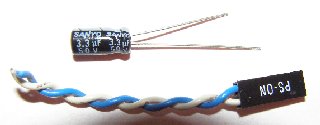
On a standard computer you push the power button and *presto* your computer powers up. What happens
is that this pushbutton momentarily completes a circuit, letting the ATX power supply know to turn itself on.
When the PC is inside an enclosure, you don't want to have to open it up to reach inside and turn on
the computer each time you want to use the device.
Some motherboards support a feature called "Resume After Power Failure" which will turn the computer
on after power is cut.
If your motherboard doesn't support this feature, or if you simply want another option, I describe
here what I call "The Capacitor Trick."
One electrolytic capacitor, value under 10µf, at least 10V
One motherboard feature connector

Trim the leads of the capacitor so they're both the same length.
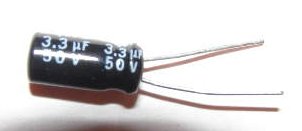
Slide the ends of the legs into the top of the feature connector. Get them between the wall of the
connector and the pin inside.
Alternatively, you could solder the wires to the leads on the cap, then shield each lead with heat
shrink, electrical tape or whatnot.
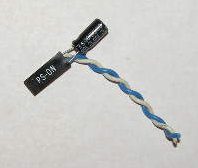
That takes care of the assembly. Now for the application, you have to make sure you place
the capacitor with the polarity going the right way, otherwise it won't work.
Your motherboard must be hooked up to a power supply, and must be plugged in.
Just remember, with it plugged in, you can short out stuff if you bridge the wrong components, so be careful!
Locate the power connector pins on your motherboard. CAREFULLY place
the leads of a multimeter on each pin.
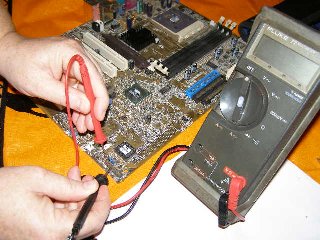
Read the number on the meter. It should be around five volts.
If the number is positive, then the pin that the black lead is on is the negative
pin. The capacitor must have it's negative lead on that pin.
If the number is negative, then the pin that the red lead is on is the negative
pin. The capacitor must have it's negative lead on that pin.
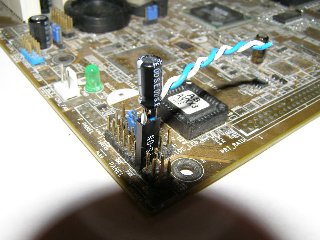
A capacitor's discharged state is shorted. When you apply power to the unit,
the cap acts as a short between the pins, activating the power supply.
With 5V flowing through the cap, its shorted state becomes an open state,
allowing the board to boot normally.
When you power down the unit, the capacitor will discharge, and resume its shorted
state, allowing it to do this the next time you power up.
Arthur Peale
October 15, 2006